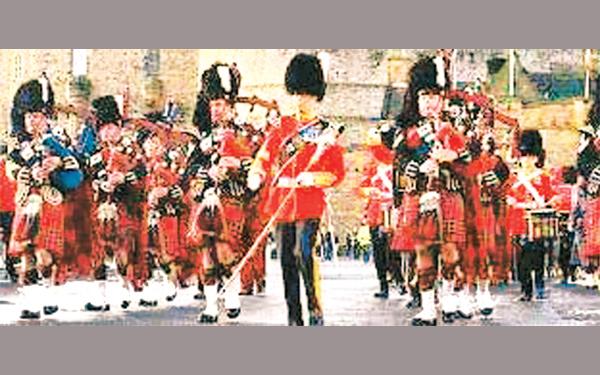
The bagpipe is a wind instrument that consists of two or more reed pipes. The reeds are vibrated by the wind, caused by the pressuring of the arm on a skin/cloth bag. The pipes are held in wooden sockets tied into the bag, which is inflatedby the mouth. Melodies are played on the finger holes of the melody pipe, or chanter, while the remaining pipes, or drones, sound single notes. An important related instrument is the Irish union (or uilleann) pipes.
 |
| A carving of an angel playing bagpipes in the Thistle Chapel, Edinburgh, Scotland |
Bagpipes have always been made in many shapes and sizes. Medieval bagpipes usually had a single drone. Around 1,400, most shepherd-style bagpipes acquired a second drone. Bagpipes were traditionally made from whole sheepskins, cowhides or goatskins.
The skin would be turned inside out and pipes would be placed where the legs and neck would have been. At present, bagpipes are usually made with artificial fabric such as Gore-Tex, which is synthetic and waterproof.
Although the bagpipes are widely assumed to be a Scottish invention, they actually have a lengthy history.
Their origin is widely disputed, with references to them existing in ancient Rome and Egypt over 3000 years ago. When the Romans brought the bagpipes to Scotland with them more than 2000 years ago, the Scots made the famous wind instrument their own by adding the third drone to the bagpipe around 1550.
 |
| An old picture of a Scotsman playing the bagpipe |
The bagpipe is mentioned in the Bible, and some historians believe that it originated in Samaria (present-day Israel) or China. Through the migration of the Celts, tribesmen from Central Europe, it was introduced to Persia and India, and later to Greece and Rome. In fact, a Roman historian wrote that the Roman Emperor Nero knew how to play the bagpipe with his mouth with the bag thrust under his arm. During the Middle Ages the bagpipe was heard and appreciated by all levels of society.
The bagpipe probably originated as a rustic instrument in many cultures because a herdsman had the materials at hand to make one: a goat skin or sheep skin and reed pipes.
There is evidence that bagpipes have been played throughout Europe since the Norman Conquest, the conquering of England in 1066 by William, the French Duke of Normandy.
After the 15th century some were used for court music, and others have survived as military instruments. In modern times, bagpipes are commonly found in pipe bands and military bands around the world.
They are also used to remember and mourn the departed at funerals and memorials.
When playing, it is best to hold the bagpipes with the bass drone over your non - dominant shoulder.
You should inflate the bagpipes by blowing into the blowpipe, and then keep the bag inflated to emit sounds from the drones.The tone of the bagpipe is modulated (changed) from drone reeds, which are cylinders of wood split into two pieces.
The player has to move the reed when playing to adjust the tuning. The bagpipe has come a long way through history, and its popularity isn’t going to wind down any time soon. It is a quite interesting musical instrument, even though it is difficult to practise and I hope some of you will take it up.

Dinara Hettiarachchi
Grade 8
Ananda College
Colombo 10
